Safflower
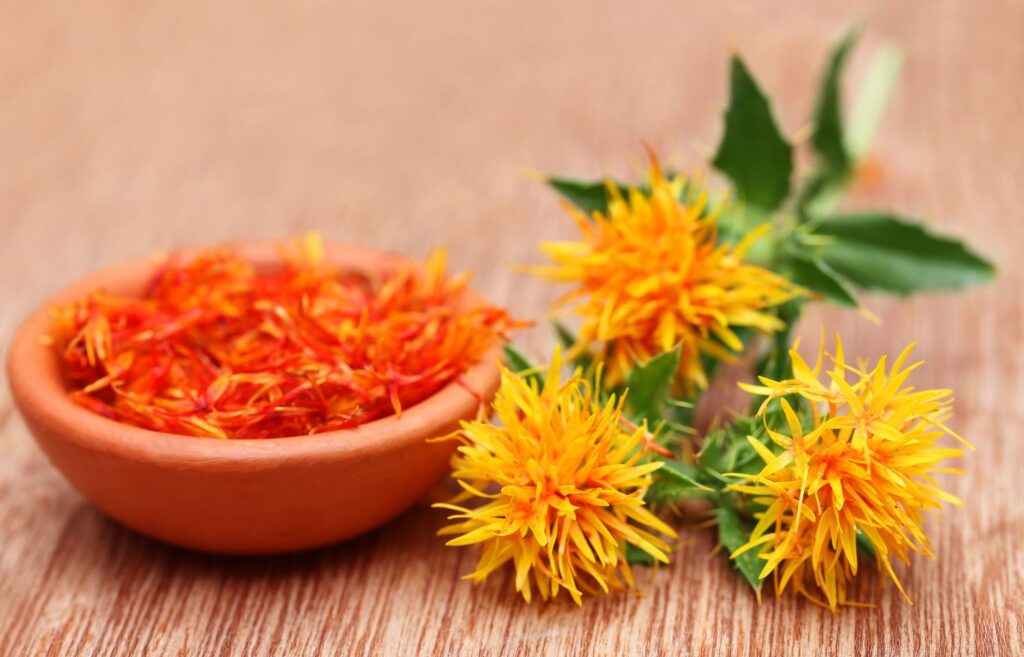
Safflower is a vibrant herb known for its bright yellow, orange, or red flowers, which are harvested for their seeds and petals. The plant is primarily cultivated for its oil-rich seeds, which have various culinary and industrial uses. Safflower has been used for centuries in traditional medicine and as a natural dye. The herb is drought-resistant and thrives in dry climates, making it a valuable crop in arid regions.
1. Size:
Safflower plants typically grow to a height of 1 to 4 feet (30 to 120 cm). The stems are slender and branch out near the top, supporting the colorful flower heads.
2. Color:
The flowers of the Safflower plant range in color from bright yellow to deep orange and red. The seeds are white or light brown, encased in a hard shell.
3. Texture:
The leaves of the Safflower plant are rough and spiny, with a slightly jagged edge. The flowers, when dried, become brittle and papery.
4. Fragrance:
Safflower flowers have a mild, earthy scent, which becomes more pronounced when dried. The oil extracted from the seeds is virtually odorless.
5. Uses:
- Safflower oil, extracted from the seeds, is commonly used in cooking due to its high smoke point and mild flavor. The petals are also used as a saffron substitute for coloring and flavoring dishes.
- Safflower petals are used in traditional medicine to support heart health, reduce inflammation, and promote menstrual health.
- The vibrant petals of Safflower are used as a natural dye for textiles, cosmetics, and food.
- Safflower oil is used in the production of paints, varnishes, and other industrial products.
6. Habitat:
Safflower thrives in dry, arid climates and is often grown in regions with hot summers and low rainfall. It prefers well-drained soil and full sunlight, making it a resilient crop in challenging environments.
7. Cultural and Spiritual Significance:
- In traditional Chinese medicine, Safflower is associated with blood circulation and is used to treat various ailments related to the heart and blood.
- Safflower has been used historically in Middle Eastern and Mediterranean cultures as a dye, a flavoring agent, and a medicine.
- Safflower is sometimes used in spiritual practices to promote healing and vitality, particularly in rituals aimed at enhancing physical and emotional well-being.
Spiritual Properties
- Healing Energy: Safflower is believed to carry strong healing energy, particularly related to the heart and circulatory system.
- Protection: The herb is thought to offer protective qualities, especially in matters related to health and well-being.
- Vitality: Safflower is associated with vitality and life force, making it a symbol of strength and resilience.
Medicinal Properties
- Heart Health: Safflower oil is rich in unsaturated fats, which are beneficial for heart health. It helps lower cholesterol levels and reduce the risk of cardiovascular diseases.
- Anti-inflammatory: Safflower petals contain compounds that have anti-inflammatory properties, making them useful in treating conditions like arthritis and muscle pain.
- Menstrual Health: Safflower is traditionally used to regulate menstrual cycles and alleviate menstrual cramps due to its ability to promote blood circulation.
- Skin Health: The oil from Safflower seeds is used in skincare products to moisturize and protect the skin, particularly in treating dry or irritated skin.
Allergic Reactions
Safflower is generally considered safe for consumption and handling, particularly when used in culinary applications or as an herbal remedy.
- Skin Irritation: Handling Safflower plants, especially the spiny leaves, may cause mild skin irritation or rash in sensitive individuals.
- Respiratory Discomfort: Inhalation of Safflower pollen or dust may cause respiratory discomfort, particularly in individuals with asthma or other respiratory conditions.
- Pregnancy Complications: Safflower should be used with caution during pregnancy, as it may stimulate menstruation and could potentially lead to complications.
- Allergic Reaction: Some individuals may experience an allergic reaction to Safflower, characterized by itching, swelling, or difficulty breathing. Discontinue use if any of these symptoms occur.
- Nausea: Consuming large amounts of Safflower oil or petals may cause nausea or stomach discomfort.
- Diarrhea: Excessive intake of Safflower oil may lead to diarrhea due to its mild laxative effect.
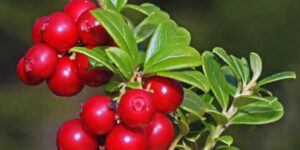
Uva Ursi
Uva Ursi Uva Ursi, also known as bearberry, is a small, evergreen shrub that is prized for its medicinal properties, particularly in treating urinary tract
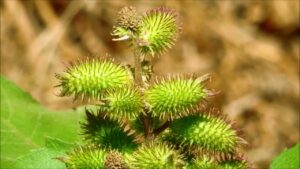
Xanthium
Xanthium Xanthium, commonly known as Cocklebur, is a herbaceous plant known for its spiky, bur-like seeds. It is a member of the Asteraceae family and
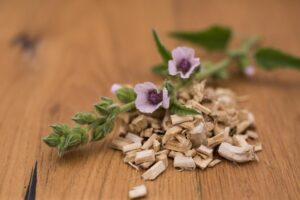
Marshmallow Leaf & Root
Marshmallow Leaf & Root Marshmallow Leaf and Root come from the Marshmallow plant (Althaea officinalis), a perennial herb known for its soothing properties. Both the
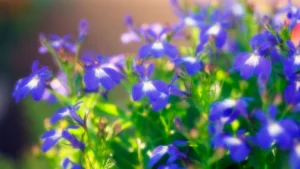
Lobelia
Lobelia Lobelia is an herb known for its distinctive blue flowers and diverse medicinal properties. It has been used in traditional medicine for its respiratory

Lemon Balm & Honey Healing Cookies
Lemon Balm and Honey Healing Cookies These light and flavorful cookies offer a perfect way to relax and soothe the spirit while enjoying a delicious
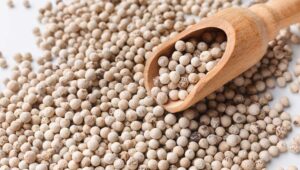
White Peppercorn
White Peppercorn White Peppercorns are derived from the same plant as black pepper, Piper nigrum, but are processed differently. They are fully ripened berries that